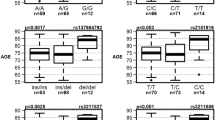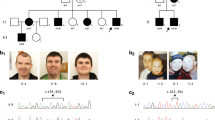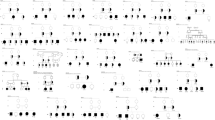Abstract
Succinate-semialdehyde dehydrogenase (SSADH) deficiency is a rare cause of learning disability. We have investigated SSADH to assess its contribution to cognitive ability in the general population in both case–control- and family-based analyses. Sequence analysis of SSADH revealed four changes affecting the encoded protein, only one of which had a minor allele whose frequency is even moderately common. We genotyped this functional polymorphism in 197 high-IQ cases, 201 average-IQ controls and 196 parent high-IQ offspring trios. The minor allele was significantly less frequent in high-IQ cases and was significantly less frequently transmitted by parents to high-IQ subjects than chance expectation. A previous study has shown that the minor allele encodes a lower activity enzyme than the major allele. These data suggest that higher SSADH activity is associated with higher intelligence across the general population. The effect is small, with each allele having an effect size translating to about 1.5 IQ points.
This is a preview of subscription content, access via your institution
Access options
Subscribe to this journal
Receive 12 print issues and online access
$259.00 per year
only $21.58 per issue
Buy this article
- Purchase on Springer Link
- Instant access to full article PDF
Prices may be subject to local taxes which are calculated during checkout
Similar content being viewed by others
References
Plomin R . Genetics and general cognitive ability. Nature 1999; 402: C25–C29.
Plomin R . Genetics, genes, genomics and g. Mol Psychiatry 2003; 8: 1–5.
Payton A, Holland F, Diggle P, Rabbitt P, Horan M, Davidson Y et al. Cathepsin D exon 2 polymorphism associated with general intelligence in a healthy older population. Mol Psychiatry 2003; 8: 14–18.
Comings DE, Wu S, Rostamkhani M, McGue M, Iacono WG, Macmurray JP . Role of the cholinergic muscarinic 2 receptor (CHRM2) gene in cognition. Mol Psychiatry 2003; 8: 10–11.
Malhotra AK, Kestler LJ, Mazzani C, Bates JA, Goldberg T, Goldman D . A functional polymorphism in the COMT gene and performance on a test of prefrontal cognition. Am J Psychiatry 2002; 159: 652–654.
Egan MF, Kojima M, Callicott JH, Goldberg TE, Kolachana BS, Bertolino A et al. The BDNF val66met polymorphism affects activity-dependent secretion of BDNF and human memory and hippocampal function. Cell 2003; 112: 257–269.
Blasi P, Boyl PP, Ledda M, Novelletto A, Gibson KM, Jakobs C et al. Structure of human succinic semialdehyde dehydrogenase gene: identification of promoter region and alternatively processed isoforms. Mol Genet Metab 2002; 76: 348–362.
Chambliss KL, Hinson DD, Trettel F, Malaspina P, Novelletto A, Jakobs C et al. Two exon-skipping mutations as the molecular basis of succinic semialdehyde dehydrogenase deficiency (4-hydroxybutyric aciduria). Am J Hum Genet 1998; 63: 399–408.
Gibson KM, Hoffmann GF, Hodson AK, Bottiglieri T, Jakobs C . 4-Hydroxybutyric acid and the clinical phenotype of Succinic semialdehyde dehydrogenase deficiency, an inborn error of GABA metabolism. Neuropediatrics 1998; 29: 14–20.
Turic D, Langley K, Mills S, Stephens M, Lawson D, Govan C et al. Follow-up of genetic linkage findings on chromosome 16p13:evidence of association of N-methyl-Daspartate glutamate receptor 2A gene polymorphism with ADHD. Mol Psychiatry.
Plomin R, Hill L, Craig IW, McGuffin P, Purcell S, Sham P et al. A genome-wide scan of 1842 DNA markers for allelic associations with general cognitive ability: a five-stage design using DNA pooling. Behav Genet 2001; 31: 497–509.
Lubinski D, Benbow CP . The first three decades of a planned 50-year study of intellectual talent. In: Subotnik R, Arnold K (eds). Beyond Terman: Longitudinal Studies in Contemporary Gifted Education. Ablex: Norwood, NJ, 1994 pp 255–281.
Lubinski D, Webb RM, Morelock MJ, Benbow CP . Top 1 in 10 000: a 10-year follow-up of the profoundly gifted. J Appl Psychol 2001; 86: 718–729.
Flynn J . Searching for justice: the discovery of IQ gains over time. Am Psychol 1999; 54: 5–20.
Wechsler D . Wechsler Intelligence Scale for Children – Revised. The Psychological Corporation: New York, 1974.
Wechsler D . Wechsler Adult Intelligence Scale-III. New York: The Psychological Corporation, 1997.
Freeman B, Powell J, Ball DM, Hill L, Craig IW, Plomin R . DNA by mail: an inexpensive and noninvasive method for collecting DNA samples from widely dispersed populations. Behav Genet 1997; 27: 251–257.
Austin J, Hoogendoorn B, Buckland P, Speight G, Cardno A, Bowen T et al. Comparative sequencing of the proneurotensin gene and association studies in schizophrenia. Mol Psychiatry 2003; 5: 208–212.
Norton N, Williams NM, Williams HJ, Spurlock G, Kirov G, Morris DW et al. Universal, robust, highly quantitative SNP allele frequency measurement in DNA Pools. Hum Genet 2002; 110: 471–478.
Bray NJ, Buckland PR, Owen MJ, O'Donovan MC . Cis-acting variation in the expression of a high proportion of genes in human brain. Hum Genet 2003; 113: 149–153.
Cash CD, Maitre M, Mandel P . Purification from human brain and some properties of two NADPH-linked aldehyde reductases which reduce succinic semialdehyde to 4-hyrdoxybutyrate. J Neurochem 1979; 33: 1169–1175.
Ewens WJ, Spielman RS . The transmission/disequilibrium test: history, subdivision, and admixture. Am J Hum Genet 1995; 57: 455–464.
Mott DD, Lewis DV . Facilitation of the induction of long-term potentiation by GABAB receptors. Science 1991; 252: 1718–1720.
Paulsen O, Moser EL . A model of hippocampal memory encoding and retrieval: GABAergic control of synaptic plasticity. Trends Neurosci 1998; 21: 273–278.
White AM, Platt B . Ionic mechanisms of GABA-induced long-term potentiation in the rat superior colliculus. Exp Brain Res 2001; 140: 486–494.
Leung LS, Wu C . Kindling suppresses primed-burst-induced long-term potentiation in hippocampal CAI. NeuroReport 2003; 14: 211–214.
Crestani F, Keist R, Fritschy JM, Benke D, Vogt K, Prut L et al. Trace fear conditioning involves hippocampal α5 GABAA receptors. Neurobiology 2002; 99: 8980–8985.
Costa RM, Federov NB, Kogan JH, Murphy GG, Stern J, Ohno M et al. Mechanism for the learning deficits in a mouse model of neurofibromatosis type 1. Nature 2002; 415: 526–530.
Ioannidis JP, Ntzani EE, Trikalinos TA, Contopoulos-Ioannidis DG . Replication validity of genetic association studies. Nat Genet 2001; 29: 306–309.
Cardon LR, Bell J . Association study designs for complex diseases. Nat Genet 2001; 2: 91–99.
Glatt CE, Freimer NB . Association analysis of candidate genes for neuropsychiatric disease: the perpetual campaign. Trends Genet 2002; 18: 307–312.
Lohmueller KE, Pearce CL, Pike M, Lander ES, Hirschhorn JN . Meta-analysis of genetic association studies supports a contribution of common variants to susceptibility to common disease. Nat Genet 2003; 33: 177–182.
Cohen J . Statistical Power Analysis for the Behavioral Sciences. Lawrence Erlbaum Associates: Hillsdale, NJ, 1988.
Plomin R . Genetic research on general cognitive ability as a model for mild mental retardation. Int Rev Psychiatry 1999; 11: 34–36.
Plomin R, Spinath FM . Genetics and general cognitive ability (g). Trends Cogn Sci 2002; 6: 169–176.
Thompson PM, Cannon TD, Narr KL, van Erp T, Poutanen VP, Huttunen M et al. Genetic influences on brain structure. Nat Neurosci 2001; 4: 1253–1258.
Gray JR, Chabris CF, Braver TD . Neural mechanisms of general fluid intelligence. Nat Neurosci 2003; 6: 316–322.
Egan MF, Kojima M, Callicott JH, Goldberg TE, Kolachana BS, Bertolino A et al. The BDNF val66met polymorphism affects activity-dependent secretion of BDNF and human memory and hippocampal function. Cell 2003; 112: 257–269.
Acknowledgements
The research was funded by US National Institute of Child Health and Human Development Grant HD27694. Other researchers who have contributed to the current phase of the IQ QTL Project include Ian W Craig, Shaun Purcell and Pak Sham, King's College London; Nigel M Williams, University of Wales College of Medicine; Lee A Thompson, Case Western Reserve University; and David Lubinski, Vanderbilt University.
Author information
Authors and Affiliations
Corresponding author
Rights and permissions
About this article
Cite this article
Plomin, R., Turic, D., Hill, L. et al. A functional polymorphism in the succinate-semialdehyde dehydrogenase (aldehyde dehydrogenase 5 family, member A1) gene is associated with cognitive ability. Mol Psychiatry 9, 582–586 (2004). https://doi.org/10.1038/sj.mp.4001441
Received:
Revised:
Accepted:
Published:
Issue Date:
DOI: https://doi.org/10.1038/sj.mp.4001441
Keywords
This article is cited by
-
Determination of system level alterations in host transcriptome due to Zika virus (ZIKV) Infection in retinal pigment epithelium
Scientific Reports (2018)
-
Characterization of the DYX2 locus on chromosome 6p22 with reading disability, language impairment, and IQ
Human Genetics (2014)
-
Comparative genomics of aldehyde dehydrogenase 5a1 (succinate semialdehyde dehydrogenase) and accumulation of gamma-hydroxybutyrate associated with its deficiency
Human Genomics (2009)
-
The Impact of Genetic Research on our Understanding of Normal Cognitive Ageing: 1995 to 2009
Neuropsychology Review (2009)
-
Genetic foundations of human intelligence
Human Genetics (2009)



